 |
 |





 |
 |
 |
 |
 |
 |
Posters challenge employees to use creativity, innovation to help Shape Our Future
|
 |
 |
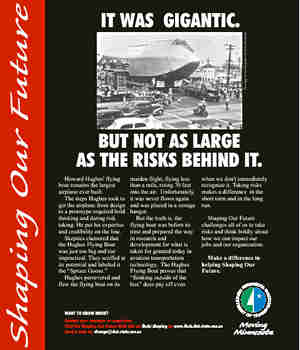 |
The districts and Central
Office this week received a series of 10 posters for Mn/DOT's Shaping
Our Future initiative. The historical posters depict ideas and people
who bucked the conventional wisdom to overcome challenges. The poster
above describes Howard Hughes and his Spruce Goose. Poster designed
by Jane Greiner and Gary Pettis
|
Airplanes and submarines seem unlikely bedfellows in the transportation world,
but 75 years ago Charles Lindbergh married the two modes in modifying a small
monoplane named the Spirit of St. Louis.
By removing the cockpit windows to install a large fuel tank, he was able to
make the first nonstop solo flight from New York to Paris. In order for Lindbergh
to see forward as he flew, an ex-Navy submariner rigged the plane with a periscope.
Lindbergh’s inspirational story is just one of many told in a series of 10
new Shaping Our Future posters distributed this week throughout the districts
and Central Office. Each poster provides an anecdote about ideas or people who
bucked the conventional wisdom in order to meet some challenge.
"The posters put change and risk-taking—the hallmarks of Shaping Our Future—into
historical perspective," said Gary Pettis, communications manager, Communications
and Public Relations. "They offer examples of how innovation and hard work
pay off, with the hope of inspiring employees to find new ways of meeting the
challenges we as an organization face."
This set of posters is a follow-up to a poster distributed statewide in May
that introduced the Shaping Our Future concept and key messages. Later this
summer, another set of 10 posters will talk about Shaping Our Future in the
context of Mn/DOT events.
Besides being located in most Mn/DOT buildings, the posters are also available
at http://ihub.dot.state.mn.us./shaping/posters.html
for viewing or printing.
There are a number of ways you can get more information about Shaping Our
Future, including talking to your manager or supervisor, accessing the main
Shaping Our Future Web site,
calling 1-888/749-8155 or sending questions to change@dot.state.mn.us.
By Chris Joyce
|
back

|
 |
Hiawatha light-rail budget kept on track
|
 |
 |
This week the Hiawatha Project Office made some changes to the $675.4 million
Hiawatha Line light rail project to keep it on budget.
The cuts were agreed upon June 17 at a meeting of the Hiawatha LRT Corridor
Management Committee. Commissioner Elwyn Tinklenberg and Metropolitan Council
Chair Ted Mondale attended the meeting.
"We have made a commitment to build this line on time and on budget,"
Tinklenberg said. "This responsibility is more important than ever with
Minnesotans feeling the effects of budget shortfalls statewide."
Projections indicate that contingency expenses would exceed budgeted amounts
by $9.5 million. The Hiawatha light rail project has a contingency fund of $29.5
million, or 4.4 percent of the total budget—a modest amount compared to other
major construction projects. Some areas that will have higher-than-budgeted
costs include right-of-way acquisition, public utility relocation and contaminated
soil removal.
Project officials have committed to reducing project costs by more aggressively
managing project expenses. Metro Transit will operate a light rail fleet of
24 (instead of 26) vehicles. The original plan included 22, but when bids came
in below expected costs, the number increased to 26 vehicles.
The cities of Minneapolis and Bloomington and the Metropolitan Airports Commission
have also identified items to remove or defer. Many of the items were expansions
on the original scope of work.
"This is not the last time that we will deal with changes to stay on budget,"
Tinklenberg said. "This is part of an ongoing process to ensure that we
deliver a world-class transportation option to the people of Minnesota while
meeting our financial responsibilities."
Metro Transit officials indicated that the proposed changes will not have a
negative impact on ridership.
By Josh Collins, Hiawatha Project Office
|
back

|
 |
Seeds program honors founder Ike McCrary at 9th anniversary celebration
|
 |
 |
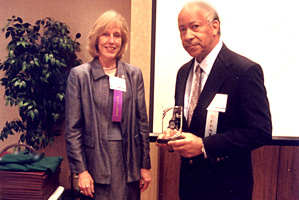 |
|
Management Operations
Group Director Linda Bjornberg presents the Pioneer Award to Ike McCrary,
retired rail planner and founder of Mn/DOT's Seeds Program. Photo by
Craig Wilkins
|
Leaders of Mn/DOT’s Seeds Program honored its founder, Ike McCrary, and its
newest graduates during the annual Seeds Day celebration on June 13 in Minneapolis.
McCrary, a retired rail planner, received the first Pioneer Award for his vision
and commitment to the Seeds program. About 160 people attended the event, including
past and present Seeds students, supervisors, mentors, management, community
members and college representatives.
Since the program began in 1993, Seeds has recruited bright and capable people
to Mn/DOT from traditionally underrepresented groups, according to Emma Corrie,
current Seeds program manager. Seventy-five Seeds graduates have been placed
in permanent positions at Mn/DOT, while several others have moved on to successful
careers with other state agencies or in the private sector.
Seeds graduate Zakariye Mohamed, a Minneapolis Community and Technical College
student who works in the Office of Information Resource Management, credits
the program and his mentor with giving him his own chance at the American dream.
"When Seeds was established, it was just fantastic for me," he said.
"I came here from Somalia in 1995, and without Seeds, I would not be here
at all. Steve McGregor, a Seeds graduate himself, has been very helpful—a great
Seeds mentor."
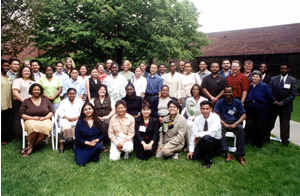 |
|
Seeds students, past
and present, gather at the annual Seeds Day celebration June 13. Since
its inception in 1993, the program has placed 75 students from underrepresented
groups in permanent positions at Mn/DOT. Photo by Craig Wilkins
|
In addition to honoring McCrary with the Pioneer Award, Management Operations
Group Director Linda Bjornberg handed out the following awards:
-
Seeds student of the year: Carla Martin
-
Seeds mentor of the year: Louise Breidel
-
Seeds supervisor of the year: John Moreland
-
Leadership Award: Margo LaBau
-
Office of the Year: Information Resource Management (for permanent placement
of Seeds graduates)
-
Special Recognition Award: Emeric Pratt (for the Seeds mentoring program)
Commissioner Elwyn Tinklenberg and Chief of Staff Margo LaBau stressed the
need for Mn/DOT and other public agencies to show leadership in hiring, training
and retaining a workforce that reflects the state’s increasingly diverse population.
Bjornberg, Corrie and Felisa Flowers, Seeds Development Committee member, talked
about the future direction of Seeds. Goals include building a diverse pool of
highly qualified candidates, providing students with quality work experiences
and development opportunities, and placing more Seeds graduates in permanent
positions.
For more information about the program, contact Corrie at 651/297-3897 or visit
the Seeds Web site.
By Craig Wilkins
|
back

|
 |
Recruitment efforts extend to Juneteenth celebration
|
 |
 |
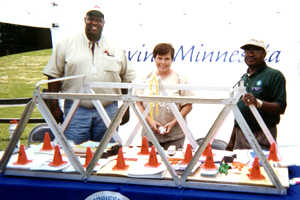 |
Volunteers were at the
booth to answer visitors’ questions concerning Mn/DOT’s job opportunities.
From left: DeWayne Jones, Golden Valley Truck Station supervisor; Sue
Zeches, Metro Human Resources personnel officer; and Emeric Pratt, Human
Resources community liaison. Photo by Gary Pettis
|
An estimated 25,000 people—including several Mn/DOT employees—attended the
Juneteenth celebration held June 15 at Theodore Wirth Park in Minneapolis. Mn/DOT
volunteers staffed a recruitment booth that included a snowplow truck, which
was featured in the parade opening the annual event. Attached to the truck was
a banner that read: "Is your career path snowbound? We’ll clear that too."
"The Juneteenth celebration is an excellent event to reach diverse candidates
who have or can acquire the distinctive skills Mn/DOT needs to stabilize its
workforce," said Emeric Pratt, Human Resources community liaison.
 |
|
Roosevelt Johnson, assistant
supervisor at Golden Valley Truck Station, speaks to a prospective employee
about transportation jobs. Photo by Emeric Pratt
|
Because Mn/DOT faces the possibility of losing one-third of its highly skilled
workforce by 2004, there’s an increased need for the department to attract new
employees, Pratt said. Events such as Juneteenth will help the department recruit
highly motivated employees with diverse talents and skills while maintaining
the highest quality of service in transportation, he added.
Juneteenth is the oldest known celebration of the ending of slavery and dates
back to June 19, 1865—more than two years after President Abraham Lincoln ended
slavery with the Emancipation Proclamation. For more information about Juneteenth,
see: http://www.juneteenth.com/worldwide.htm
and http://www.juneteenth.com/whatisjuneteenth.htm.
By Daneeka Marshall-Oquendo
|
back

|
 |
Three more Minnesota scenic byways ‘go national’
|
 |
 |
 |
Winding roads and rolling
hardwood-covered hills like these on Hwy 16 near Lanesboro can be found
on the Historic Bluff Country Scenic Byway. Photo by David Larson
|
Three Minnesota scenic byways have become national scenic byways or All American
roads last week, more than doubling Minnesota’s contribution to the America’s
Byways list. The three routes—Historic Bluff Country Scenic Byway, the Minnesota
River Valley Scenic Byway, and the County Road 61 section of the North Shore
Scenic Drive—were among 36 additions announced last week by U.S. Transportation
Secretary Norman Mineta.
County Road 61, which is the western extension of the North Shore Scenic Drive,
joined the Hwy 61 portion on the All American Road list. The completed route
follows the Lake Superior shoreline from Canal Park in Duluth to Grand Portage
near the Canadian border. An All American Road—according to national guidelines—must
have nationally significant qualities, unique features and be a "destination
unto itself."
The other two routes—Historic Bluff Country Scenic Byway and the Minnesota
River Valley Scenic Byway—are now on the National Scenic Byway list. A National
Scenic Byway must be regionally significant and possess archaeological, cultural,
historic, natural, recreational or scenic qualities.
The Historic Bluff Country Scenic Byway follows Hwy 16 from LaCrosse to Dexter
in the southeastern corner of Minnesota.
The Minnesota River Valley Scenic Byway begins at Browns Valley on Minnesota’s
South Dakota border, follows the river southeast to Mankato, and follows the
river north to the Twin Cities Metro area, ending at Belle Plaine.
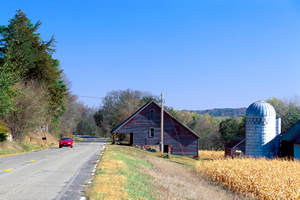 |
|
Some of the most productive
agricultural practices in the world can be found along the Minnesota River
Valley Scenic Byway. Other more historic attractions highlight the Civil
War, Indian treaties and the Native Americans and Euro-American immigrants
who struggled to make their lives here. Photo by David Larson
|
The three routes are also among 20 routes currently designated as Minnesota
Scenic Byways, said Mark Anderson, principal state planner, Office of Environmental
Services. The other state scenic byways on the national list are the Great River
Road along the Mississippi River, the Edge of the Wilderness Byway north of
Grand Rapids and the Grand Rounds Scenic Byway in Minneapolis.
"There are actually two tiers of scenic byways," Anderson said. "The
national program was established by the Intermodal Surface Transportation Efficiency
Act in 1992. Minnesota began its program about the same time as the national
program. The ISTEA guidelines for national scenic byways contain 14 elements
and the National Byways go through an even more rigorous review process than
at the state level."
Anderson said that Minnesota has an inter-agency Scenic Byway Commission that
decides which byways should be state scenic byways. The commission also sets
policy, coordinates activities, and receives and ranks applications for Scenic
Byways Discretionary Grants.
"The Scenic Byway program provides a catalyst for communities to cooperate
in activities that might draw visitors," Anderson said. "Tourism is
one of the top three industries in Minnesota."
By Marsha Storck
|
back

|
 |
Sustainable Transportation Section moves to CO, will become part of Transit office
|
 |
 |
The Sustainable Transportation Section moved from its offices in the Kelly
Inn to the Central Office on June 14 and will be incorporated into the Office
of Transit on July 1. The section is currently part of the Office of Environmental
Services.
The section's new offices are on the third floor adjacent to the Office of
Transit. Telephone numbers for staff members remain unchanged as does their
mail stop, MS 315.
The section includes Darryl Anderson, Kristie Billiar, Jim Dustrude, Mark Fiers,
Mary Jackson, Mark Lober, Michelle Natrop and Bob Works, section manager. The
section’s work supports bicycling, walking and telework as modal elements of
Mn/DOT's developing a coordinated transportation network.
Works said that by joining the Office of Transit, the Sustainable Transportation
Section will become more directly involved with transit, other modal offices
and districts for enhanced modal integration. For example, he said, when a transit
system plans service improvements, the section will be better positioned to
assist with planning bike and pedestrian facilities that support the bus operation.
|
back

|
|
 |
|



